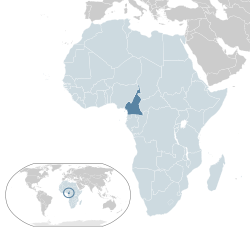Republic of Cameroon République du Cameroun (French) | |
|---|---|
| Motto: "Paix – Travail – Patrie" (French) "Peace – Work – Fatherland" | |
| Anthem: "Chant de Ralliement" (French) "The Rallying Song" | |
| Capital | Yaoundé 3°52′N 11°31′E / 3.867°N 11.517°E |
| Largest city | Douala |
| Official languages | English French |
| Ethnic groups (2022) |
|
| Religion (2022) |
|
| Demonym(s) | Cameroonian |
| Government | Unitary dominant-party presidential republic under a dictatorship |
| Paul Biya | |
| Joseph Ngute | |
| Marcel Niat Njifenji | |
| Cavayé Yéguié Djibril | |
| Legislature | Parliament |
| Senate | |
| National Assembly | |
| Formation | |
| 17 August 1884 | |
Partition | 20 July 1916 |
Independence of French Cameroon from France | 1 January 1960 |
Independence of Southern Cameroons from the United Kingdom, establishment of federal republic | 1 October 1961 |
Unitary state | May 1972 |
| Area | |
Total | 475,442 km2 (183,569 sq mi) (53rd) |
Water (%) | 0.57 |
| Population | |
2024 estimate | 30,966,105 (52nd) |
Density | 39.7/km2 (102.8/sq mi) |
| GDP (PPP) | 2024 estimate |
Total | |
Per capita | |
| GDP (nominal) | 2024 estimate |
Total | |
Per capita | |
| Gini (2021) | medium inequality |
| HDI (2022) | medium (151st) |
| Currency | Central African CFA franc (XAF) |
| Time zone | UTC+1 (WAT) |
| Date format | dd/mm/yyyy yyyy/mm/dd |
| Calling code | +237 |
| ISO 3166 code | CM |
| Internet TLD | .cm |
| |
Table of Contents
Introduction to Occupational Health and Safety in Cameroon
Occupational health and safety (OHS) standards play a crucial role in safeguarding the well-being of workers in Cameroon. Over the years, the recognition of OHS as a fundamental aspect of labor rights has evolved, reflecting a growing awareness of the need to protect employees from workplace hazards. Historically, various factors, including economic development, globalization, and the adoption of new technologies, have contributed to the changing landscape of workplace safety in the country.
In Cameroon, occupational health and safety measures have witnessed significant advances, particularly in response to the high incidence of work-related accidents and illnesses. The impact of these occupational hazards is severe, not only affecting the health of workers but also leading to financial losses for employers and the national economy. As a result, the importance of establishing comprehensive OHS standards cannot be overemphasized, as these standards are critical for promoting a safe working environment in various sectors.
The Cameroonian government, alongside various stakeholders, has recognized the necessity of implementing effective health and safety measures to enhance worker protection. This has led to the formulation of laws and regulations aimed at regulating workplace conditions across industries. Although progress has been made, challenges remain in the consistent enforcement of these regulations. Companies, particularly small and medium-sized enterprises, often lack the resources required to implement robust OHS practices.
Moreover, the awareness of occupational health and safety among workers and employers is still developing. Educating individuals about their rights and the importance of adhering to safety protocols is imperative for fostering a culture of prevention. Addressing these issues will not only improve workers’ rights but also enhance overall productivity while reducing the incidence of workplace injuries and illnesses. Thus, the overview of occupational health and safety standards in Cameroon is a vital step toward ensuring a safer working environment for all.
Legal Framework Governing Occupational Health and Safety
In Cameroon, the legal framework for occupational health and safety is predominantly established through the provisions outlined in the Labor Code and associated regulations. The Labor Code serves as the cornerstone of labor legislation, addressing various aspects of workplace rights and responsibilities. It aims to create a conducive working environment that safeguards the health and safety of workers, particularly in industries susceptible to occupational hazards.
Among the significant provisions in the Labor Code, specific articles are dedicated to ensuring workplace safety and health conditions. These articles mandate employers to implement necessary measures that protect employees from potential risks associated with their jobs. This includes the obligation to maintain appropriate working conditions, provide adequate training, and supply necessary personal protective equipment. Furthermore, employers are required to conduct regular risk assessments to identify hazards and continuously improve safety protocols.
In addition to the Labor Code, several decrees and regulations supplement the legal framework, reinforcing the importance of occupational health and safety. These regulations aim to align national standards with international guidelines, particularly those set forth by the International Labour Organization (ILO). By incorporating these international standards, Cameroon demonstrates its commitment to promoting a safe working environment while adhering to global best practices.
Moreover, the legal framework also outlines penalties for non-compliance, which serves as an incentive for employers to prioritize the well-being of their employees. Inspectors from the Ministry of Labor and Social Security are responsible for enforcing these regulations, conducting inspections, and ensuring that employers adhere to the established legal requirements. Through this regulatory framework, Cameroon strives to enhance occupational health and safety standards, reflecting both national priorities and international obligations.
Employer Responsibilities Under OHS Standards
Employers play a pivotal role in upholding Occupational Health and Safety (OHS) standards, as their responsibilities directly influence the safety and well-being of employees in the workplace. One of the foremost duties of employers is to establish and maintain a safe working environment. This involves not only the physical aspects of the workplace but also the psychological climate that can affect employees’ mental health. Employers must ensure that the workplace is free from hazards that could potentially harm workers, thereby contributing to a culture of safety.
Conducting thorough risk assessments is another critical responsibility that falls upon employers. This process entails identifying potential health and safety risks associated with specific tasks or equipment and subsequently implementing strategies to mitigate these risks. Regular assessments help in creating a proactive approach towards safety, allowing for timely interventions before accidents occur. It is essential that employers update these assessments periodically and whenever there is a significant change in the workplace.
Moreover, employers are required to provide adequate training for their staff regarding safety practices and protocols. This training should encompass the proper use of safety equipment, awareness of workplace hazards, and emergency response procedures. As employees often are the first line of defense in recognizing hazards, equipping them with knowledge is vital in enhancing workplace safety.
Lastly, employers must ensure the availability and maintenance of necessary safety equipment. This includes personal protective equipment (PPE) such as helmets, gloves, and eye protection, which are crucial in safeguarding workers against potential injuries. By actively fulfilling these responsibilities, employers not only comply with OHS standards, but also cultivate an environment that values the health and safety of all employees, ultimately leading to enhanced productivity and job satisfaction.
Government Role in OHS Enforcement and Inspections
The government of Cameroon plays a pivotal role in the enforcement of occupational health and safety (OHS) standards, ensuring that workplaces comply with established regulations designed to protect employees. Various governmental bodies are responsible for monitoring, regulating, and implementing OHS protocols across different sectors. The Ministry of Labour and Social Security is the primary agency overseeing these efforts, supported by local labor inspectorates that operate within specific regions. These institutions work collaboratively to create a safer working environment and mitigate workplace risks.
The process of conducting inspections begins with the preparation of an inspection plan that outlines the scope and frequency of inspections to be carried out. Inspectors equipped with the necessary training and resources perform routine visits to workplaces to assess compliance with health and safety standards. This includes examining safety equipment, reviewing training records, and evaluating workplace conditions. The inspection reports generated not only highlight areas of compliance but also identify deficiencies that require immediate rectification.
To ensure adherence to safety regulations, the government employs a range of strategies. One prominent method is the provision of guidelines and resources aimed at educating employers and employees about OHS compliance. Additionally, the government can impose penalties on organizations failing to meet safety standards. These penalties may include fines, suspension of operations, or even legal action in severe cases of non-compliance. Regular training workshops and awareness programs are also organized to enhance understanding of safety practices among workers and management alike.
The commitment of the Cameroon government to enforcing OHS standards showcases its dedication to creating a safer workplace for its citizens. By actively monitoring compliance and conducting inspections, the government is essential in reducing workplace accidents and promoting a culture of safety.
Common Occupational Hazards in Cameroon
Cameroon, like many developing countries, faces numerous occupational hazards that impact workers across various industries. Understanding these risks is vital for the health and safety of the workforce. The construction, agriculture, and manufacturing sectors, in particular, have been noted for their exposure to hazards that can lead to injuries or adverse health effects.
In the construction industry, workers frequently encounter physical hazards such as falling objects, unguarded machinery, and unsafe scaffolding. These risks increase the likelihood of accidents, resulting in serious injuries or fatalities. Additionally, exposure to dust and noise pollution poses further health threats. The implementation of safety measures, such as proper training and the use of personal protective equipment (PPE), is essential to mitigate these dangers.
Agriculture, a key sector in Cameroon, presents its own range of hazards. Workers are often exposed to chemical risks from pesticides and herbicides, which can lead to acute and chronic health issues if not handled correctly. Ergonomic risks are also prevalent in this sector, as many laborers engage in repetitive motions or sustain poor postures over extended periods. These factors can lead to musculoskeletal disorders that significantly affect workers’ overall health.
In the manufacturing industry, workers often face exposure to hazardous chemicals and machinery, which can pose both physical and biological risks. The production process may involve handling toxic substances without proper safety protocols, leading to long-term health implications. Biological hazards such as mold and bacteria can also be an issue, particularly in food processing plants. Ensuring compliance with safety standards and promoting a culture of health and safety are critical steps in addressing these occupational hazards.
Given the diverse industries in Cameroon, it is imperative for employers and policymakers to prioritize the identification and mitigation of these common occupational hazards to safeguard the health and well-being of workers.
Penalties for Non-Compliance with OHS Standards
Compliance with occupational health and safety (OHS) standards is imperative for ensuring a safe working environment. In Cameroon, failure to adhere to these standards can lead to significant repercussions for employers. The extent of the penalties imposed varies depending on the severity and frequency of the violations, as well as the specific laws applicable to each case.
Legal repercussions commonly include hefty fines levied against employers who neglect their responsibilities pertaining to OHS regulations. These fines serve not only as punitive measures but also as deterrents aimed at encouraging compliance across industries. For instance, recurrent safety violations can result in escalated financial penalties, emphasizing the seriousness with which the Cameroonian government views workplace safety. Additionally, the laws clearly stipulate that employers may face imprisonment if found guilty of severe negligence leading to workplace injuries or fatalities. This reflects a broader commitment to holding employers accountable for their actions or inactions regarding employee safety.
Another significant consequence of non-compliance is the potential for operational shutdowns of businesses. Authorities have the right to suspend operations of establishments that continually disregard safety regulations. Such actions aim to not only protect employees but also to uphold public safety standards. The implications of non-compliance extend beyond legal penalties; they also affect employee rights. Workers subjected to unsafe working conditions may seek legal recourse for their grievances. This can lead to a rise in workplace disputes and decreased workforce morale, ultimately impacting productivity.
In summary, the penalties for failing to comply with OHS standards in Cameroon are multifaceted, encompassing financial or criminal liabilities, business interruptions, and adversely affecting employees’ rights and safety. Employers must prioritize adherence to these regulations to foster a secure work environment and minimize legal risks.
Promoting a Culture of Safety in the Workplace
Creating a culture of safety in the workplace is essential for organizations in Cameroon, where occupational health and safety standards are increasingly prioritized. A robust safety culture not only enhances employee well-being but also contributes to the overall efficiency of the organization. To foster this environment, businesses must implement strategies that actively involve employees, ensuring that safety is a shared responsibility.
Employee involvement is crucial in cultivating a safety-first mindset. Encouraging workers to participate in safety discussions and decision-making processes can significantly raise awareness about potential hazards. This engagement empowers employees, making them feel valued and more inclined to adhere to safety protocols. Regular safety meetings, workshops, and feedback sessions can facilitate dialogue between management and staff, further strengthening the organization’s commitment to safety.
Training is another pivotal element in promoting a culture of safety. Organizations in Cameroon should prioritize regular safety training sessions that are tailored to various job functions and risks associated with specific tasks. Training programs should cover topics such as emergency response, proper use of personal protective equipment (PPE), and the identification of workplace hazards. By ensuring that employees are well-informed and equipped with the necessary skills, organizations can mitigate risks and reduce the likelihood of accidents.
Effective communication regarding safety practices is vital in maintaining an ongoing culture of safety. Organizations should utilize various channels to disseminate information, ensuring that all employees are kept updated on safety policies, procedures, and any changes that may occur. Clear signage, safety bulletins, and digital communication platforms can help in conveying important safety messages consistently. Moreover, establishing a feedback mechanism allows employees to report unsafe conditions or suggest improvements, promoting a proactive approach to safety management.
In conclusion, cultivating a culture of safety within organizations in Cameroon requires the active participation of all employees, regular and relevant training, and effective communication. By prioritizing these elements, businesses can create a safer workplace that not only protects employees but also enhances operational success.
Challenges in Implementing OHS Standards in Cameroon
Implementing Occupational Health and Safety (OHS) standards in Cameroon presents numerous challenges that hinder the effective safeguarding of workers’ well-being. One significant challenge is the limited availability of resources, including both financial and technical support. Many businesses, particularly small and medium-sized enterprises, lack the necessary funds to invest in safety equipment, training, and the implementation of health protocols. This financial constraint often leads to inadequate safety measures, putting employees at risk in various sectors, particularly those that are labor-intensive.
Another critical issue is the lack of awareness regarding OHS standards among employers and employees alike. Many workers are not fully informed about their rights to a safe working environment, nor do they understand the implications of inadequate safety measures. This lack of knowledge extends to employers, who may not recognize their responsibilities under existing OHS regulations. Consequently, this results in minimal investment in safety training and a general disregard for health protocols, leading to unsafe workplace conditions.
Enforcement issues further complicate the situation. Regulatory bodies tasked with overseeing workplace safety often face challenges that limit their effectiveness. These include insufficient staffing, lack of training for inspectors, and inadequate legal frameworks to punish non-compliance. Without proper enforcement of existing standards, businesses may continue to operate with little regard for OHS regulations, exacerbating the risks faced by workers.
Compliance levels vary significantly across different sectors, with industries such as construction and agriculture often exhibiting lower adherence to safety practices compared to others. This disparity highlights the need for tailored approaches to promote health and safety that consider the unique challenges encountered in different fields. Attention must be directed towards these factors to improve adherence to OHS standards, thereby ensuring a safer environment for all workers across Cameroon.
Future Directions for Occupational Health and Safety in Cameroon
As Cameroon continues to evolve economically and socially, the importance of robust occupational health and safety (OHS) standards cannot be overstated. Future developments in this critical area are essential to ensure the well-being of workers across various industries. A multi-faceted approach that involves policy reforms, enhanced regulatory frameworks, and investment in training programs is necessary to address current challenges and pave the way for a safer working environment.
Firstly, it is crucial for Cameroon to prioritize the establishment and enforcement of comprehensive occupational health and safety regulations. By revising existing legislation to align with international standards, the government can create a more conducive environment for worker safety. Including provisions for regular inspections and compliance checks will help ensure adherence to OHS standards, ultimately reducing workplace accidents and health issues.
Investment in training programs cannot be overlooked. Providing ongoing education and training for both employers and employees about occupational health practices and safety measures will enhance awareness and compliance. These programs should be designed to cater to the diverse industries present in Cameroon, from agriculture to manufacturing, ensuring that the specific risks associated with each sector are adequately addressed.
Furthermore, stakeholder collaboration is vital for improving health and safety outcomes. By involving government bodies, employers, trade unions, and non-governmental organizations in the development of OHS policies, a holistic approach can be adopted. Stakeholder engagement promotes a sense of shared responsibility, leading to more effective implementation of health and safety standards in the workplace.
In conclusion, the future of occupational health and safety in Cameroon depends on the collective effort of all parties involved. By focusing on policy reforms, regulatory enhancements, targeted training, and collaboration, Cameroon can ensure a safer and healthier work environment for its workforce, aligning itself with global best practices in occupational health and safety. This holistic approach not only benefits workers but also enhances productivity and economic growth in the long run.



